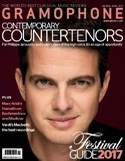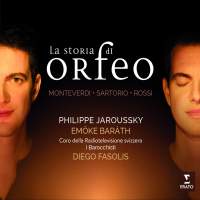Texte paru dans: / Appeared in: |
|
|
Outil de traduction (Très approximatif) |
|
|
Reviewer:
Alexandra Coghlan
On their album ‘Il pianto d’Orfeo’ (DHM, 1/15) Scherzi Musicali collated repertoire to similar effect, creating a collage rather than a narrative. L’Arpeggiata’s ‘Orfeo Chamán’ (Erato, 10/16) was more dramatically coherent, pairing freshly composed material with folk and historical music, and earlier this year tenor Thomas Hobbs strung a sequence of lute songs together to conjure a day in the life of Orpheus (Paraty) What sells ‘La storia’ is its functionality. This hour-long fusion of Rossi’s Orfeo, Sartorio’s L’Orfeo and Monteverdi’s L’Orfeo would make a brilliant concert cantata, exposing two comparatively neglected operas while also throwing the familiar Monteverdi into new relief. Each work has its own strengths, and this pick-and-mix approach embraces all of them. Rossi’s madrigal-like ensembles (‘Ah, piangete!’, ‘Dormite begl’occhi’) bridge the divide between Monteverdi’s choruses and duets, while Sartorio’s melodic gift gives us a handful of attractive pastoral numbers, including the exquisite ‘Cara e amabile’. Monteverdi is represented in lively choruses, extended recitatives and, of course, the extraordinary ‘Possente spirto’ – recorded here for the first time by a countertenor. If the project does feel like an elaborate excuse to facilitate this particular land-grab by Jaroussky, it’s one well worth indulging. Any fears that Jaroussky’s feathery tone might prove insufficiently flexible and varied for this extended episode are quickly dispelled, as he moves from husky despair to assertive persuasion. His is, perhaps inevitably, a more youthful, fragile Orpheus than from a typical tenor, but the effect is moving, especially when set against Emo˝ke Baráth’s wonderfully charred soprano, glints of brightness tempered by smoky darkness.
Fasolis directs a highly textured
performance by I Barrochisti, bringing real depth to recitatives and dances
alike, and the singers of the Coro della Radio Svizzera serve neatly as both
step‑out soloists and ensemble. What could look like a musical gimmick is
actually an effective way of reclaiming and repackaging repertoire. While the
Rossi could plausibly stand alone, who would ever stage the flawed Sartorio?
What a shame there wasn’t space to add Caccini’s Euridice into the mix as
well. |
|




